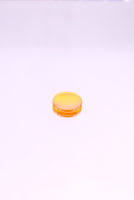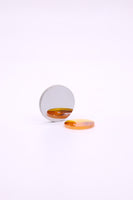Choosing the right laser lens is critical for achieving accurate focus, clean cuts, and high-resolution engraving. The lens determines how the beam interacts with your material, shaping the spot size, focal depth, and energy concentration. Whether you're processing wood, acrylic, rubber, or coated metals, the laser lens directly affects output quality, job speed, and system efficiency.
This guide breaks down the technical aspects of selecting a laser lens that aligns with your specific materials, applications, and performance goals.

1. What is a Laser Lens?
A laser lens is the optical component in a CO₂ laser system that focuses the raw beam into a precise point. That focal point influences how well your laser engraves or cuts by determining:
- Spot Size – The diameter of the focused beam. A smaller spot means higher detail and resolution.
- Focal Length – The distance between the lens and the point where the beam converges into focus.
- Depth of Field – The range (above and below the focal point) where the beam stays acceptably sharp.
Different lenses are engineered to prioritize either cutting depth, engraving detail, or a balance of both. Understanding how these variables interact is essential to optimizing your setup.
2. Common Laser Lens Focal Lengths and When to Use Them
Laser lenses are classified by focal length, which impacts how the beam behaves at the material surface:
- 1.5" Lens (38.1 mm): Best for fine-detail engraving. Produces a tight beam and shallow depth of field—ideal for text, logos, and image engraving on flat, thin materials.
- 2.0" Lens (50.8 mm): The most versatile choice. Balances engraving precision and moderate cutting depth. Performs well on materials up to 6 mm thick.
- 2.5" Lens (63.5 mm): Offers a greater depth of field, making it suitable for cutting thicker or slightly uneven materials like MDF, neoprene, or layered stock.
- 4.0" Lens (101.6 mm): Designed for deep cutting or engraving tall items. Used in specialty cases like thick acrylic, foam, or stacked materials where maintaining beam focus is critical across Z-height.
Each lens represents a trade-off: shorter focal lengths offer better detail, while longer lenses handle thicker materials and surface variations better.

Here's a quick-check table for you to choose your right lens in various situations:
|
Lens Focal Length |
Spot Size |
Depth of Field |
Best For |
Material Thickness |
Application Type |
|
1.5" (38.1 mm) |
Very small (tight) |
Shallow |
Fine-detail engraving, small text, logos, raster image engraving |
Thin, flat materials (< 3 mm) |
|
|
2.0" (50.8 mm) |
Small (balanced) |
Moderate |
Mixed-use: general engraving and light cutting |
Up to ~6 mm |
All-purpose engraving and cutting |
|
2.5" (63.5 mm) |
Medium |
Deep |
Cutting thicker or uneven materials (e.g., MDF, rubber, neoprene) |
~6–10 mm |
Deep vector cuts, engraving over uneven areas |
|
4.0" (101.6 mm) |
Larger |
Deepest |
Deep cuts, foam, thick acrylic, or stacked jobs |
>10 mm |
Specialty deep cutting, tall workpieces |
Learn more: Laser Cutter, Engraving Settings for Different Materials
3. What to Look for When Choosing the Right Laser Lens
Selecting the right laser lens goes beyond just size, it involves understanding how the lens interacts with your laser tube and material stack. Consider the following:
- Material Type and Thickness: Thin, flat materials do well with short focal lengths; thick or uneven materials benefit from longer focal lengths that increase focus tolerance.
- Application Type: For photo engraving or fine raster work, use a short focal length. For production cutting, prioritize deeper focus and spot stability.
- Detail Requirements: If you're engraving intricate fonts or linework, a 1.5" or 2.0" lens delivers finer results.
- Laser Tube Compatibility: RF tubes generally produce a smaller beam diameter, which benefits from high-resolution lenses. DC tubes may require adjustments in power and focus. Learn more: RF CO2 Laser Vs Glass Tube CO2 laser - Which Better?
- Throughput and Speed: A longer focal length covers more vertical range but often needs slower speeds. Balance performance and speed based on your workflow demands.
4. When to Change Your Laser Lens
Even with high-quality optics, laser lenses aren't lifetime components. Replace or switch lenses when:
- You're shifting to a new job type or material group.
- Detail quality drops or cutting edges become rougher.
- You need more passes to complete tasks that were once faster.
- Your laser tube is upgraded and requires a beam-matched lens for best focus.
Keep multiple lens types on hand to stay adaptable, especially in production environments with diverse job requests.
5. Tips When Choosing Laser Lens
5.1 Match Lens to Primary Application
First, determine whether your workflow leans more toward engraving or cutting:
- Engraving: Use a 1.5" or 2.0" lens to produce a narrow spot size for detailed logos, barcodes, and raster images.
- Cutting: Opt for a 2.5" or 4.0" lens to penetrate thicker material with smoother edge finish and fewer focus issues.
5.2 Consider Material Flatness and Height Variation
Warped boards, foam, or stacked layers require more tolerance in focus. A 2.5" or 4.0" lens provides a wider depth of field, ensuring consistent results across varying Z-heights.
5.3 Account for Power Distribution
Short focal lengths concentrate laser energy tightly. This increases intensity but may cause scorching on delicate materials. For substrates like paper, fabrics, or thin films, a longer lens offers more controlled energy delivery.
5.4 Lens Quality Affects Results
Optics vary by manufacturer. Look for:
- AR-Coated ZnSe Lenses: Minimize reflective loss and resist surface contamination.
- Precision-Ground Optics: Offer uniform energy distribution, reducing hot spots or fringe distortion during engraving.
5.5 Stock Multiple Lenses for Flexibility
A well-rounded toolkit should include:
- 2.0" lens for general use
- 1.5" lens for engraving detail
- 2.5" or 4.0" lens for thick or uneven material
This combination allows you to quickly adapt without sacrificing cut quality or turnaround time.
6. Maintenance and Compatibility Considerations
Laser lenses are optical-grade components and must be treated accordingly:
- Material: Most are made from ZnSe (Zinc Selenide); AR-coated versions last longer and transmit more beam energy.
- Mount Compatibility: Confirm your laser head accepts your lens diameter (commonly 20 mm or 25 mm).
- Cleaning: Wipe lenses regularly with lens-safe wipes and lens cleaner or alcohol to remove soot and prevent power loss.
- Replacement: Inspect weekly for discoloration, pitting, or beam flare. Any damage reduces beam focus and increases job time or quality issues.
Proper care not only improves engraving consistency but extends the life of your optics and system.
Learn more: How to Clean Laser Lens

FAQs
Q1. What is the difference between a 2.0" and a 2.5" laser lens?
A 2.0" lens creates a tighter beam with a shorter focal range, perfect for engraving fine details. A 2.5" lens has a larger spot size but cuts deeper and tolerates height variation better.
Learn more: Perfect Laser Beam Alignment – How to Align a Laser Beam
Q2. Can I use one lens for both cutting and engraving?
Yes, a 2.0" lens is a good all-rounder. However, for demanding engraving or cutting jobs, dedicated lenses optimize speed and clarity.
Q3. How do I know if my laser lens needs replacing?
If you see reduced power, inconsistent lines, excessive charring, or visual fogging or scratches, it's time to clean or replace the lens.
Q4. Does focal length affect cutting speed?
Absolutely. Shorter lenses focus energy into a smaller area—cutting thin materials faster. Longer lenses are better for thicker material but may need slower speeds to maintain cut quality.
Q5. What focal length is best for photo engraving?
A 1.5" lens is ideal for photo engraving. It produces a small spot size that captures fine detail and grayscale tones on wood, leather, or anodized metals.
Have Questions? Contact Us Now!
Conclusion
Selecting the right laser lens is a foundational part of dialing in laser quality and productivity. Whether you're cutting thick acrylic or engraving photo-realistic designs, the lens dictates how effectively your laser transfers energy into the material.
By understanding focal lengths, spot size, and beam dynamics—along with maintaining your lenses regularly—you'll achieve cleaner edges, sharper engraving, and greater repeatability. A well-chosen lens isn't just a laser accessory—it's a performance multiplier.
Let us know if you'd like help matching a lens to your current setup, or need a starter pack with the most commonly used focal lengths.

 Liquid error (sections/image-banner line 171): invalid url input
Liquid error (sections/image-banner line 171): invalid url input





